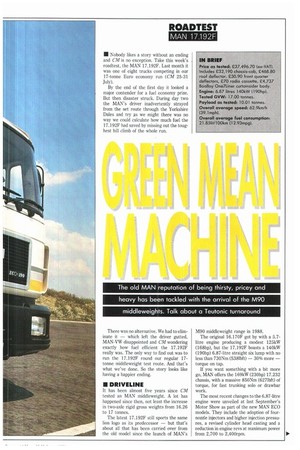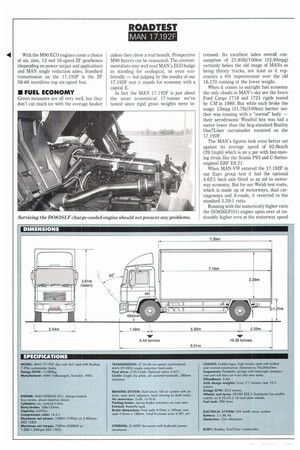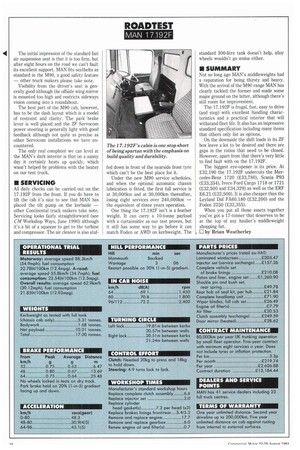• Nobody likes a story without an ending and CM
Page 25

Page 26

Page 27

Page 28

If you've noticed an error in this article please click here to report it so we can fix it.
is no exception. Take this week's roadtest, the MAN 17.192F. Last month it was one of eight trucks competing in our 17-tonne Euro economy run (CM 25-31 July).
By the end of the first day it looked a major contender for a fuel economy prize. But then disaster struck. During day two the MAN's driver inadvertently strayed from the set route through the Yorkshire Dales and try as we might there was no way we could calculate how much fuel the 17.192F had saved by missing out the toughest hill climb of the whole run.
There was no alternative. We had to eliminate it — which left the driver gutted, MAN-VW disappointed and CM wondering exactly how fuel efficient the 17.192F really was. The only way to find out was to run the 17.192F round our regular 17tonne middleweight test route. And that's what we've done. So the story looks like having a happier ending.
• DRIVELINE
It has been almost five years since CM tested an MAN middleweight. A lot has happened since then, not least the increase in two-axle rigid gross weights from 16.26 to 17 tonnes.
The latest 17.192F still sports the same lion logo as its predecessor — but that's about all that has been carried over from the old model since the launch of MAN's M90 middleweight range in 1988.
The original 16.170F got by with a 5.7litre engine producing a modest 125kW (168hp), but the 17.192F boasts a 140kW (190hp) 6.87-litre straight six lump with no Less than 730Nrn (5381bft) — 30% more — torque on tap.
If you want something with a bit more go, MAN offers the 169kW (230hp) 17.232 chassis, with a massive 850Nm (6271bft) of torque, for fast trunking solo or drawbar work.
The most recent changes to the 6.87-litre engine were unveiled at last September's Motor Show as part of the new MAN ECO models. They include the adoption of fournozzle injectors and higher injection pressures, a revised cylinder head casting and a reduction in engine revs at maximum power from 2,700 to 2,400rpm.
With the M90 ECO engines come a choice of six, nine, 12 and 16-speed ZF gearboxes (depending on power output and application) and MAN single reduction axles. Standard transmission on the 17.192F is the ZF S6-66 overdrive top six-speed box.
• FUEL ECONOMY
Green measures are all very well, but they don't cut much ice with the average haulier unless they show a real benefit. Prospective M90 buyers can be reassured. The environmentalists may well read MAN's ECO badge as standing for ecological, or even ecofriendly — but judging by the results of our 17.192F test it stands for economy with a capital E.
In fact the MAN 17.192F is just about the most economical 17-tonner we've tested since rigid gross weights were in
creased. Its excellent laden overall consumption of 21.851it/100km (12.93mpg) certainly belies the old image of MANs as being thirsty trucks, not least as it represents a 6% improvement over the old 16.170 running at the lower weight.
When it comes to outright fuel economy the only clouds in MAN's sky are the Iveco Ford Cargo 1718 and 1721 rigids tested by CM in 1989. But while each broke the magic 13mpg (21.711t/100km) barrier neither was running with a "normal body — their aerodynamic Windfoil box was half a metre lower than the bog-standard Boalloy One7Liner curtainsider mounted on the 17.192F.
The MAN's figures look even better set against its average speed of 62.9km/h (39.1mph) which is on a par with fast-moving rivals like the Scania P93 and C-Seriesengined ERF E8.21.
When MAN-VW entered the 17.192F in our Euro group test it had the optional 4.62:1 back axle fitted as an aid to motorway economy. But for our Welsh test route, which is made up of motorways, dual carriageways and A-roads, it reverted to the standard 5.29:1 ratio.
Running with the numerically higher ratio the D0826LF(01) engine spins over at noticeably higher revs at the motorway speed
limit than the 4.29:1 equipped chassis but for the best all-round performance in terms of acceleration and gradeability the 5.29 ratio provides the best compromise.
• DRIVEABILITY Readers glancing at the comparison charts may be surprised to see the 17.192F set against what appears to be more powerful models. The reason for our choice is simple. With 6.87 litres to play with the M90 MAN has the kind of torque that most rivals with similar horsepower. can only wish for.
Of the dozen or so 17-tonners we have tested only three chassis: the Cargo 1721, ERF E8.21, and Scania P93 have more torque from their larger capacity engines.
The 17.192F's extra grunt certainly made itself known during our 0-80km/h acceleration tests and on the steep timed hill climb out of Wantage.
With its 730Nin (5381bft) of torque deliv ered between 1200, and 1,500rpm the ECO engine provides a flexible drive. Changing gear between 2,000 and 2,100rpm puts the rev counter needle nicely back to just before the start of the solid green economy band which begins at 1,400rpm. On gentle slopes and easy bends the charge-cooled six-pot pulls happily down to 1,000rprri and still recovers. The ZF six-speed box suits the MAN engine well, but there are some noticeable gaps in its ratios. Second gear is just too deep to pull away from rest, so first is needed to get the 17.192F rolling but not much more than that. Deliver a hefty right foot in first and the rev needle zooms alarmingly towards the red on the tachometer. However, the worst jump is between third and fourth.
The most tiresome aspect of the ZF box is its high shift loads notchy is not the word. The gate may be well defined, but you almost need two hands to wrestle the stick into reverse.
The 17.192F's brisk performance is more than matched by its excellent ride and handling and its solid roll stability. It is predictable at all times and encourages rapid progress through winding roads.
Braking on the ECO MAN is also reassuring. During our full pressure stops from 64km/h (40mph) the 17,192F pulled up only slightly out of line without any wheels locking up. Its overall stopping distances are particularly good and against its test rivals they are consistently shorter.
• CAB COMFORT At a time when truck manufacturers are making their cabs as attractive as possible ........................... CA•1 20-26 ./e/y 89 cob 5.484tre 152k W (20.7hpl ........................................................... it is reassuring to come across one which has kept the stylists firmly in hand.
The M90 day cab may be rather sombre with few frills, but it shouts out build quality. The dark interior looks capable of taking the kind of hammering delivered to spot rental and The heavy-duty etarvuyc.dks-y and still look good. T cloth seat covers and door inserts will hide the dirt and there is a nice touch of a leather patch placed across the bottom front corner of the door trim where drivers have a habit of holding the door open with their boot.
Storage space abounds in the M90 cab. Delivery drivers have a choice of a central tray, door pockets, gloveboxes in the dash and headlining, a bin behind the seat and a whopping great cubby box which is fixed on the engine hump and doubles as a table. The initial impression of the standard Isri air suspension seat is that it is too firm, but after eight hours on the road we can't fault its excellent support. MAN fits seatbelts as standard in the M90, a good safety feature other truck makers please take note.
Visibility from the driver's seat is generally good although the offside wing minor is mounted too high and restricts sideways vision coming into a roundabout.
The best part of the M90 cab, however, has to be the dash layout which is a model of restraint and clarity. The park brake lever is well placed and the ZF Servocorn power steering is generally light with good feedback although not quite as precise as other Servocom installations we have encountered.
The only real complaint we can level at the MAN's dark interior is that on a sunny day it certainly heats up quickly, which wasn't helped by problems with the heater on our test truck.
• SERVICING
All daily checks can be carried out on the 17.192F from the front. If you do have to tilt the cab it's nice to see that MAN has placed the tilt pump on the kerbside other Continental truck makers take note. Servicing looks fairly straightforward (see CM Workshop Ways, June 1990) although it's a bit of a squeeze to get to the turbine and compressor. The air cleaner is also stuf
fed down in front of the nearside front tyre which can't be the best place for it.
Under the new M90 service schedules, and when the optional automatic chassis lubrication is fitted, the first full service is at 30,000km and at 30,000km thereafter, losing eight services over 240,000km the equivalent of three years operation.
One thing the 17.192F isn't is a feather weight. It can carry a 10-tonne payload with a curtainsider as our test proves, but it still has some way to go before it can match Foden or AWD on kerbweight. The standard 300-litre tank doesn't help, alloy wheels wouldn't go amiss either.
• SUMMARY
Not so long ago MAN's middleweights had a reputation for being thirsty and heavy. With the arrival of the M90 range MAN has clearly tackled the former and made some major ground on the latter, although there's still room for improvement.
The 17.192F is frugal, fast, easy to drive (and stop) with excellent handling characteristics and a practical interior that will withstand fleet life. It also has an impressive standard specification including many items that others only list as options.
On the downside the shift loads in its ZF box leave a lot to be desired and there are gaps in the ratios that need to be closed. However, apart from that there's very little to find fault with on the 17.192F.
The biggest eye-opener is its price. At £32,190 the 17.192F undercuts the Mercedes-Benz 1720 (£33,780), Scania P93 (£33,354), Iveco Ford Cargo 1718 or 1721 (£32,500 and £34,329) as well as the ERF E6.21 (£32,500). It is also cheaper than the Leyland Daf FA60.180 (£32,200) and the Foden 2250 (£32,355).
When you put all those assets together you've got a 17-tonner that deserves to be at the top of any haulier's middleweight shopping list.
II by Brian WeatherLey












































































